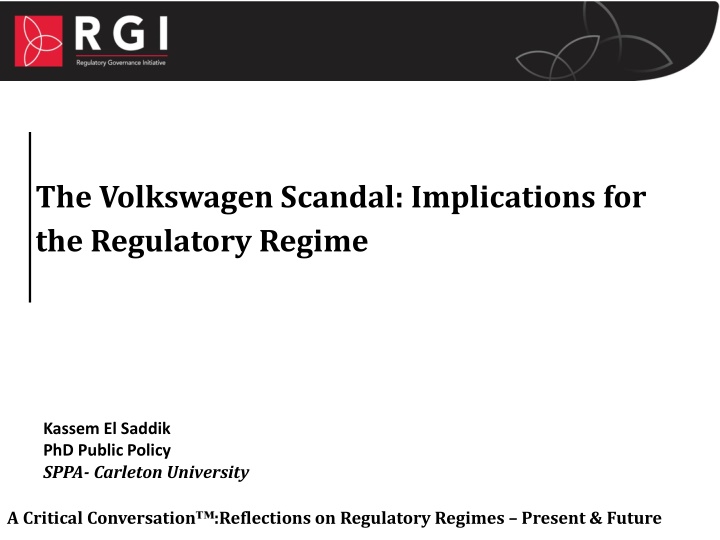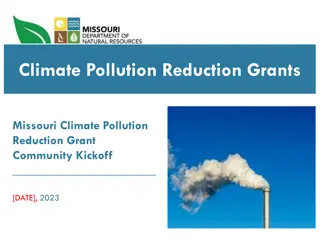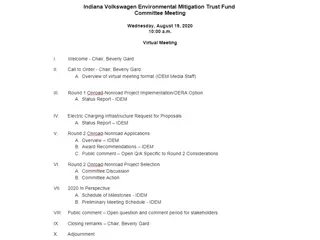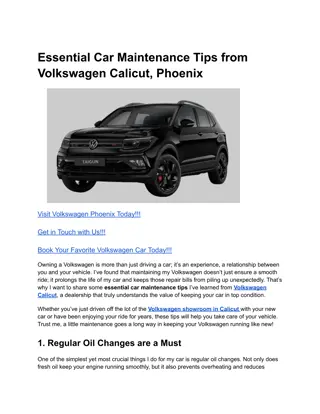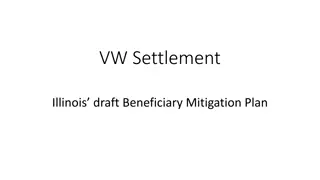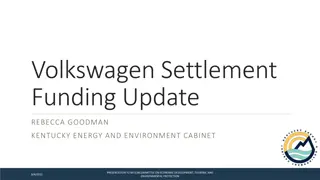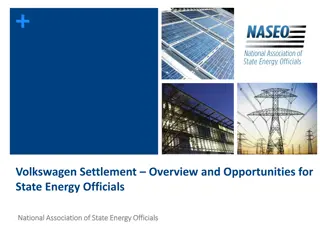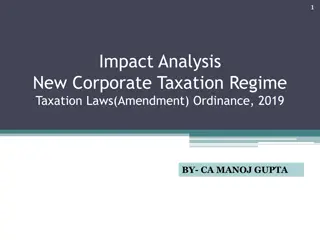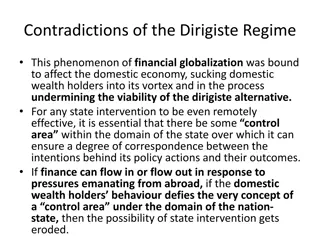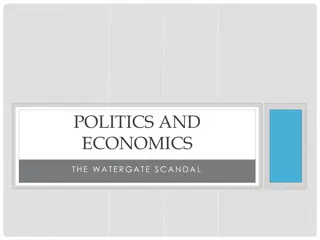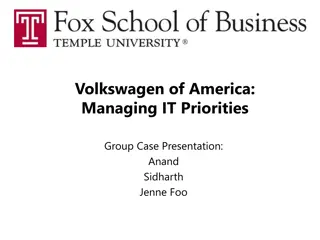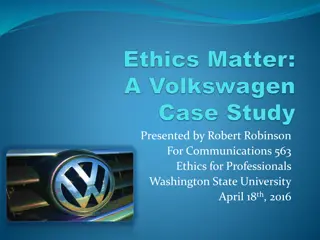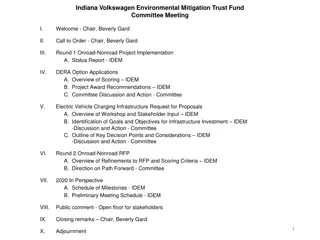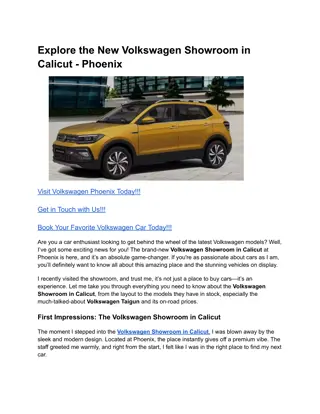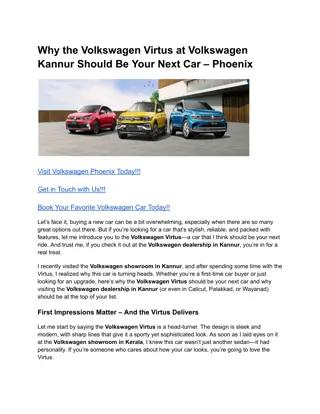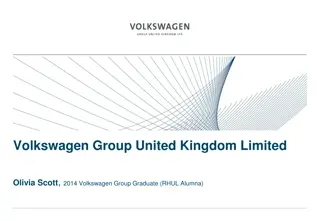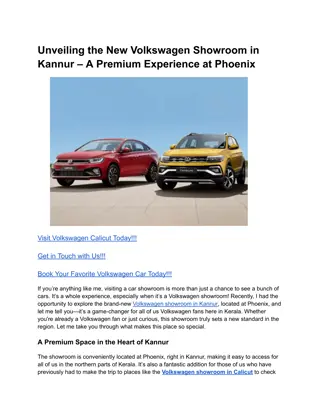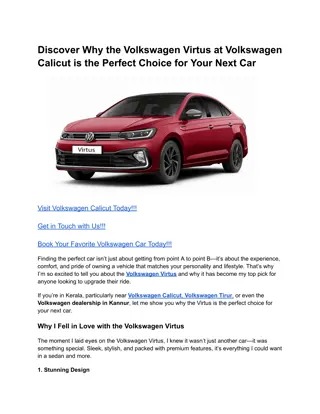Implications of Volkswagen Scandal for Regulatory Regime
The Volkswagen scandal unfolded in 2015, revealing violations of emissions standards. This critical analysis delves into the engineering of the scandal, regulatory aspects, and implications for Volkswagen and future regulatory frameworks. The scandal had far-reaching consequences, leading to massive penalties and media attention, reshaping the automotive industry's landscape.
Download Presentation

Please find below an Image/Link to download the presentation.
The content on the website is provided AS IS for your information and personal use only. It may not be sold, licensed, or shared on other websites without obtaining consent from the author.If you encounter any issues during the download, it is possible that the publisher has removed the file from their server.
You are allowed to download the files provided on this website for personal or commercial use, subject to the condition that they are used lawfully. All files are the property of their respective owners.
The content on the website is provided AS IS for your information and personal use only. It may not be sold, licensed, or shared on other websites without obtaining consent from the author.
E N D
Presentation Transcript
The Volkswagen Scandal: Implications for the Regulatory Regime Kassem El Saddik PhD Public Policy SPPA- Carleton University A Critical Conversation :Reflections on Regulatory Regimes Present & Future
Volkswagen Story The Scandal unfolds The engineering of the scandal The regulatory Aspect Many violations setting a precedence The implications of the scandal For Volkswagen Beyond Volkswagen Features of the Future Regulatory Framework
The Volkswagen Story large, ambitious, rapidly growing motor vehicle company Five Leading Vehicles Manufacturers by Global Sale (Million units) in 2014 Hyundai- Kia 8.01 It has been one of the leading carmakers in the world aiming at holding the No. 1 position in the industry by 2018 Renault-Nissan 8.5 GM 9.92 Volkswagen 10.14 Toyota 10.23 0 2 4 6 8 10 12 We want to have the most satisfied employees and customers in the world, sell more than 10 million cars a year and achieve a profit margin of more than 8 percent Martin Winterkorn (VW CEO) Source: Moving Progress, Facts and Figures - Navigator 2015, December 2014
The Volkswagen Story large, ambitious, rapidly growing motor vehicle company Vehicle Sales (in thousands)- CAGR= 8.85% 12000 Volkswagen s workforce grew at an average rate of 10.64% (2010-2015) reaching 583 thousand employees. 10000 10,217 9,728 9345 8000 8361 7278 6000 4000 2000 0 2010 2011 2012 2013 2014 Sales Revenues (in Million Euros)- CAGR=12.4% The Group has set a sustainability strategy and reported taking forward steps in the Climate Change discourse. 250,000 202,458 192,676 200,000 197,007 159,337 150,000 126,875 100,000 50,000 - 2010 2011 2012 2013 2014 Source: Moving Progress, Facts and Figures - Navigator 2015, December 2014
The scandal unfolded May 2014 3 Sept 2015 2 Nov 2015 26 Jan 2016 18 Sept 2015 1st NOV of CAA violation (2.0 L vehicles) 2nd NOV Detailed violation (3.0 L vehicles) ICCT notified CARB EPA was Notified US Justice Dpt ($46 billion penalties - CAA) Massive media exposure (Social media) Once revealed, The VW Scandal received widespread media attention with headlines fronting news website Devastating Immediate implications for VW
The engineering of the scandal The US EPA accused Volkswagen of violating key provisions in the CCA standard, particularly: 1. Noncompliance with CCA emissions bypassing, defeating, or rendering inoperative elements of the vehicle design related to compliance with CCA emission standard . 2. Selling and introducing into the market vehicles that do not conform CCA standard.
The regulatory Aspect Air Quality Act in 1967 that set the Criteria pollutants 1990 Motor Vehicle Air Pollution Control Act Significant amendments to the CAA took place in 1966, 1970, 1977 and 1990- 1967 1965 1963 1- New regulatory format 2- Tougher vehicle emissions standards Clean Air Act (CCA) 1860 s The city of Pittsburgh 1890s, Chicago and Cincinnati issued ordinance to control smoke and shoot Six Criteria Pollutants: (1) Carbon Monoxide (CO), (2) Sulfur Dioxide (SO2), (3) Nitrogen Oxides (NOx), (4) Ozone (O3), (5) Lead and (6) Particulate Matter (PM)
Yet, there has been a precedence for many violations 2015/ 16 2014 1995 1998 2011 ICCT Portable emission measurement system revealed the discrepancy between Lab and on-road emissions Volkswagen Scandal $46 billion penalties - CAA Honda EC JRC On-road emissions of diesel vehicles exceed permissible level GM $267 million 1.6 million vehicles $45 million 470 thousand vehicles Ford Motor $7.8 million 6 thousand vehicles Massive media exposure (Social media) Ironically, t took a couple of outliers (small research team) to uncover and make public what has been known within the industry for some time
The implications of the scandal USD 7.3 billion on rectifying the emissions issues May 2014 3 Sept 2015 2 Nov 2015 26 Jan 2016 18 Sept 2015 1st NOV of CAA violation (2.0 L vehicles) fell by another 17% 2nd NOV Detailed violation (3.0 L vehicles) (compared by Nov. 2014) ICCT notified CARB EPA was Notified VW Stock fell by a third (2nd week) US Justice Dpt ($46 billion penalties - CAA) ($46 billion penalties - CAA) VW Stock US Justice Dpt VW Sale fell by 25 % more than 11 million vehicles were affected by the emission violation 2.8 million in Germany alone Investors trust
Implications beyond Volkswagen Massive scale press statements by the different car manufacturers aiming at distancing themselves from the scandal, reassuring public confidence, and reiterating their compliance with the set regulations. Car Industry Rising demand for the new generation of vehicles mainly the hybrid and electric ones Confidence in Diesel Vehicles Lawsuit tsunami affecting German competitiveness German Pride
Implications beyond Volkswagen Calling for more real-time testing and enforcement to be implemented. Regulatory Regime
Features of the future regulatory framework The flexibility of Performance-based Regulation is both its principle advantage and challenge , particularly in absence of the regulators oversight and audit. (Cary Coglianese) Some key features of the future regulatory framework that should be taken into consideration : Ensure public interest not just private interest Meet statutory objectives Have effective systems and processes of transparency and public accountability Ensure and maintain a higher level of trust between the regulators and regulated on one hand, and the regulated and the general public on the other (Professor and Director of the Penn Program on Regulations at the University of Pennsylvania Law School) Thank you
